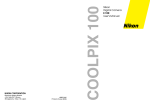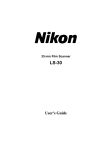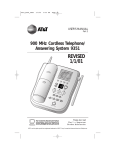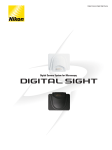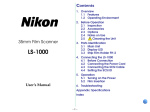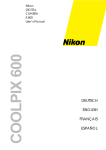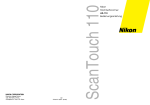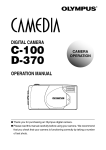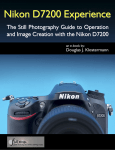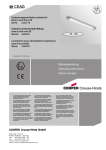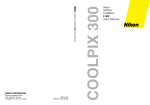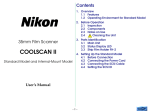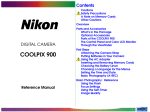Download Nikon COOLPIX E900 User's Manual
Transcript
DIGITAL CAMERA COOLPIX 900 User’s Guide Cautions • The reproduction of all or part of this manual is prohibited save in cases in which Nikon’s prior permission has been obtained. • The information contained in this manual is subject to change without notice. • Nikon has made every effort to produce a perfect manual, but should you find any mistakes, we would be grateful if you would kindly let us know. The address of Nikon’s representative in your area is provided separately. • Nikon is not liable for damages resulting from the use of this product. Important! The symbols in this manual indicate important safety precautions. Passages marked with this indication should be read before use to prevent injury to yourself or to others. ✔ Caution The ✔ symbols in this manual indicate areas in which caution is needed to avoid damaging the product. Sections marked with this symbol should be read before use to ensure that the product continues to operate properly. Trademark Information Macintosh is a registered trademark of Apple Computer Inc. Microsoft is a registered trademark, and Windows a trademark, of Microsoft corporation. IBM PC/AT is a trademark of International Business Machines Corporation. CompactFlash is a trademark of SanDisk Corporation. Adobe and Acrobat are registered trademarks of Adobe Systems Inc. All other trade names mentioned in this manual are trademarks or registered trademarks of their respective holders. ii Federal Communications Commission (FCC) Radio Frequency Interference Statement This equipment has been tested and found to comply with the limits for a Class B digital device, pursuant to Part 15 of the FCC Rules. These limits are designed to provide reasonable protection against harmful interference in a residential installation. This equipment generates, uses, and can radiate radio frequency energy and, if not installed and used in accordance with the instructions, may cause harmful interference to radio communications. However, there is no guarantee that interference will not occur in a particular installation. If this equipment does cause harmful interference to radio or television reception, which can be determined by turning the equipment off and on, the user is encouraged to try to correct the interference by one or more of the following measures: • Reorient or relocate the receiving antenna. • Increase the separation between the equipment and receiver. • Connect the equipment into an outlet on a circuit different from that to which the receiver is connected. • Consult the dealer or an experienced radio/television technician for help. CAUTION Modifications The FCC requires the user to be notified that any changes or modifications made to this device that are not expressly approved by Nikon Corporation may void the user’s authority to operate the equipment. Serial Cables Please use the serial cables supplied with your COOLPIX 900 (see page 3 of this manual). Other interface cables may exceed the limits specified for Class B devices in Part 15 of the FCC rules. Notice for customers in Canada CAUTION This class B digital apparatus meets all requirements of the Canadian Interference Causing Equipment Regulations. ATTENTION Cet appareil numérique de la classe B respecte toutes les exigences du Règlement sur le matériel brouilleur du Canada. Notice for customers in European countries ACHTUNG Dieses Gerät entspricht den Bestimmungen der EG-Direktive 87/308/EEC zur Störungsunterdrückung. Lärmemission kleiner 70 dBA. iii Safety Precautions Be sure to observe the following safety precautions when using and storing your COOLPIX 900. Do not look directly at the sun through the viewfinder Viewing the sun or other strong light source through the viewfinder could cause permanent visual impairment. Turn off immediately in the event of malfunction Should you notice smoke or an unusual smell coming from the camera, remove the batteries immediately, taking care to avoid burns. Continued operation could result in injury. After removing the batteries, take the camera to an authorized Nikon service center for information on repairs. Do not use in the presence of flammable gas Do not use electronic equipment in the presence of flammable gas, as this could result in explosion or fire. Do not disassemble Touching the camera’s internal parts could result in injury. In the event of a malfunction, the camera should be repaired only by a qualified technician. Should the camera break open as the result of a fall or other accident, remove the batteries and then take the camera to an authorized Nikon service center for information on repairs. Keep out of reach of children Particular care should be taken to prevent infants from putting the camera’s batteries or other small parts into their mouths. Do not walk while looking through viewfinder Walking while looking through the camera’s viewfinder or color LCD monitor could result in a fall or other injury. iv Other Cautions To ensure that you can continue to enjoy the use of your COOLPIX 900, you should observe the following precautions. ✔ Do not touch the lens with your fingers The proper procedure for cleaning the camera’s lens is described in “Caring for Your Camera.” ✔ Handle the lens and moving parts with care Do not apply force to the lens or to the battery, card, or connector covers. These parts are especially susceptible to damage. Do not attempt to rotate the lens and viewfinder past the limits of the hinge. When carrying the camera, do not pick the camera up by the lens. ✔ Do not drop Your camera may malfunction if subjected to strong shocks or vibration. ✔ Keep away from strong magnetic fields Do not use or store your camera in the vicinity of equipment that produces strong electromagnetic radiation or magnetic fields. The magnetic fields produced by equipment such as radio transmitters or household television sets could cause interference on the color LCD monitor, damage data stored on the flash memory card, or affect the camera’s internal circuitry. ✔ Keep dry The COOLPIX 900 is not waterproof, and may malfunction if immersed in water or exposed to high levels of humidity. ✔ Keep free of salt, sand, and dust After using your camera at the beach or seaside, wipe off any sand or salt with a lightly dampened cloth and then dry your camera thoroughly. ✔ Avoid sudden changes in temperature Sudden changes in temperature, such as occur when entering or leaving a heated building on a cold day, can cause condensation inside the camera. To prevent condensation, place the camera in its carrying case or a plastic bag before exposing it to sudden changes in temperature. v Notice concerning prohibition of copying or reproduction Note that simply being in possession of material which has been copied or reproduced by means of a digital camera may be punishable by law. Items prohibited by law from being copied or reproduced Do not copy or reproduce paper money, coins, securities, government bonds, or local government bonds, even if such copies or reproductions are stamped “Sample”. The copying or reproduction of paper money, coins, or securities which are circulated in a foreign country is prohibited. The copying or reproduction of unused postage stamps or post cards issued by the government without obtaining approval from the government is prohibited. The copying or reproduction of stamps issued by the government and certified documents stipulated by law is prohibited. Cautions on certain copies and reproductions The government has issued cautions on copies or reproductions of securities issued by private companies (shares, bills, checks, gift certificates, etc.), commuter passes, or coupon tickets, except when a minimum of necessary copies are to be provided for business use by a company. Also, do not copy or reproduce passports issued by the government, licenses issued by public agencies and private groups, ID cards, and tickets, such as passes and meal coupons. Comply with copyright notices The copying or reproduction of copyrighted creative works such as books, music, paintings, woodcut prints, maps, drawings, movies, and photographs is prohibited except when it is done for personal use at home or for similar restricted and non-commercial use. vi Contents Safety Precautions ................................................................. iv Other Cautions ............................................................................... v Overview ...................................................................... 1 Parts and Accessories ................................................ 3 What’s in this Package .................................................................. 3 Parts of the COOLPIX 900.............................................................. 4 First Steps ...................................................................... 9 Attaching the Camera Strap ................................................ 9 Putting Batteries in Your Camera ........................................ 10 Inserting and Removing Memory Cards ................................... 12 Checking the Battery Level ........................................................ 13 Choosing a Language for the Menus ....................................... 14 Setting the Time and Date ......................................................... 15 Taking Your First Photograph ....................................................... 17 Nikon View 900 .......................................................... 25 Connecting the Camera to a Computer ................................. 25 Software Installation .................................................................... 28 vii viii Overview Thank you for buying a Nikon COOLPIX 900 digital camera. The COOLPIX 900 is a full-featured digital camera with optical and digital zoom and a built-in flash. In automatic mode the camera’s programmed autofocus, autoexposure, auto white-balance, and matrix metering allow for “point-and-shoot” photography that produces excellent results in a variety conditions. The menu-driven manual mode offers a choice of metering methods, exposure compensation, and white balance programs in addition to a variety of digital effects. Photographs taken in either mode can be played back instantly on the camera’s color LCD monitor, or the camera can be connected to a television for demonstration. The COOLPIX 900 can also be attached to a computer, where your images and recordings can be viewed using the Nikon View 900 software provided with your camera, or edited for use in other applications. The manuals for your COOLPIX 900 and the Nikon View 900 browser software are divided into three parts. The User’s Guide (this manual) offers a brief introduction to using your camera and describes how to install Nikon View 900. Separate reference guides for camera and software (both Macintosh and Windows versions) are provided on CD-ROM. These reference guides can be viewed on-line or printed when you need more detailed information on using the camera and software. In addition, a onepage Fast Track Guide is provided for experienced users who want to get started with a minimum of instruction. Where appropriate, this guide will refer readers to the reference manuals or Fast Track Guide for more icon, information. References to manuals on CD are indicated by a references to the Fast Track Guide by a icon. The chapters that follow guide you, step-by-step, through the basics of using your camera and installing the browser software for your platform. The next chapter, “Parts and Accessories,” introduces you to the parts of the camera. This is followed by “First Steps,” which outlines the steps you will take after you remove the camera from the box, from inserting the batteries to taking your first photographs and playing them back. Information on installing the browser software provided with your camera may be Overview 1 found in “Nikon View 900,” which also describes how to install the Adobe Acrobat Reader software you will need to view the manuals on CD-ROM. Please read all instructions carefully to ensure that you get the most from your camera. Note: The illustrations in this manual are composites. Photographs taken with the COOLPIX 900 may differ from those shown here. Note: The illustrations in this manual show the color LCD monitor used in the NTSC-compatible model of the COOLPIX 900. Owing to differences in video standards, the PAL-compatible model will display items in positions slightly different from those shown here. 2 Overview Parts and Accessories The chapter identifies the parts of the COOLPIX 900 and lists the items packaged with your camera. What’s in this Package Purchasers of the COOLPIX 900 should find that the package contains all the items listed below. Should you notice that anything is missing or damaged, contact your retailer immediately. A PLAY OFF M REC QUAL ITY DIGT AL CAM ERA COOLPIX 900 digital camera (1) Carrying case (1) CF-4 4MB compact flashmemory card (1) AA (LR6) alkaline batteries (4) Camera strap (1) EG-900 video cable (1) Parts and Accessories: What’s in this Package SC-900 serial cable (IBM PC/ AT RS-232C) (1) SC-900M serial cable (Macintosh RS-232C/RS422) (1) Software CDROM (1) Reference CDROM (1) User’s Guide (this manual) (1) Open Me First envelope (1) and Fast Track guide (1) 3 Parts of the COOLPIX 900 [8] [6] [7] [3] [5] [4] m 4m 1 17 . 3 .4:2 .6 5. 8 - [2] FINE NORMAL BASIC AUTO SLOW [1] PLAY M REC CARD A REC [9] OFF OM NIKKO ZO R [10] [11] [12] [13] [14] W [15] T [16] [17] [18] [19] [20] NIKON CORP. BATT. MADE IN JAPAN N150 PUSH Nikon DIGITAL CAMERA E900 4.8V/6V = 0.9A/0.8A (PAL) AF [21] CARD [23] [22] 4 [25] [24] Parts and Accessories: Parts of the COOLPIX 900 [ 1] [ 2] [ 3] [ 4] [ 5] [ 6] [ 7] [ 8] [ 9] [10] [11] [12] [13] [14] [15] [16] [17] [18] [19] [20] [21] [22] Flash/Multiple Selection button Color LCD monitor Zoom switch Hole for camera strap MONITOR button MENU button Flash indicator Tripod connector Battery cover Diopter dial for adjusting viewfinder focus [23] Autofocus lamp [24] Compact flash memory card slot (under cover) [25] Battery cover release button Speedlight (flash) Red-eye reduction lamp Photocell Lens Control panel Connector for AC adapter (under cover) Connector for video cable (under cover) Selector dial/Shutter-release button Connector for serial cable (under cover) Viewfinder window QUALITY/Delete button Focus/Thumbnail button The Control Panel [2] [3] [4] [5] [1] [6] [8] [7] [9] [10] [12] [11] [ 1] [ 2] [ 3] [ 4] [ 5] [ 6] Image quality Focus setting Self-timer Digital motor-drive Flash mode Red-eye reduction indicator [ 7] Number of exposures remaining at current image quality setting [ 8] Metering mode [ 9] Exposure compensation [10] Data transfer icon [11] Memory card indicator [12] Battery indicator Parts and Accessories: Parts of the COOLPIX 900 5 The Color LCD Monitor When the selector dial is set to A-REC or M-REC, the color LCD monitor shows the view through the camera’s lens, adjusted for such settings as white balance, exposure, and digital zoom. When the dial is set to PLAY, the monitor displays the most recently recorded photograph. The MONITOR button below the monitor controls whether camera settings or recording information will be shown superimposed on the image displayed, and can also be used to turn the monitor off, increasing battery life. In manual (M-REC) and playback (PLAY) modes, pressing the MENU button causes the settings menus for the current mode to be displayed. The zoom-out (W/▼) and zoom-in (T/▲) buttons are used to highlight the various menu items. The currently highlighted menu item can be selected by pressing the shutter button. W T Zoom switch MONITOR button MENU button When the monitor is on and information is shown, pressing the MONITOR button will hide the information display. Pressing the button a second time will turn the monitor off. To turn the monitor on, press the MONITOR button once. 6 Parts and Accessories: Parts of the COOLPIX 900 Camera settings (A-REC, M-REC) Zoom indicator Battery indicator Autoexposure lock White-balance lock Self-timer Lens adapter Image adjustment Number of exposures remaining VGA indicator Image quality Metering Exposure compensation White balance program Focus setting Recording information (PLAY) Date and time of recording Filename (the first four letters of the filename are omitted) Battery indicator Protected image Image quality Position in memory Parts and Accessories: Parts of the COOLPIX 900 7 Through the Viewfinder [1] [2] [3] [1] Macro close-up field-of-view Use this frame when composing photographs with focus set to macro close-up (appropriate at ranges of 8cm–50cm, or 3˝–20˝) [2] Focus point indicator For best autofocus results, compose photograph with subject at focus point [3] Field of view at ranges of 50cm (20˝) to infinity 8 Parts and Accessories: Parts of the COOLPIX 900 First Steps This chapter guides you through the steps you will take after removing the camera from the box, from inserting the batteries to making your first photographs and playing them back. Before you will be able to use your camera, you will need to: • attach the camera strap • insert batteries • insert the compact flash-memory card • choose the language to be used in the setting and playback menus • set the camera’s clock-calendar to the current date and time These tasks are detailed on the pages that follow. Once these steps have been completed, your camera will be ready to take photographs and play them back as described at the end of this chapter. More detailed information on camera settings and on playing images back may be found in the camera reference manual on CD-ROM. Attaching the Camera Strap Attach the camera strap as shown below. Note: Feed at least 5 cm (2″) of the strap through the final hole. Keep the strap over your shoulder or around your wrist when carrying the camera. Caution To prevent accidental strangulation, do not place the camera strap around your neck. Special care should be taken to avoid placing the strap around the neck of an infant or child. First Steps: Attaching the Camera Strap 9 Putting Batteries in Your Camera 1. Turn the camera off When putting new batteries in your camera, first rotate the selector dial to OFF. If the camera is on a tripod, the camera must be removed from the tripod before the batteries can be replaced. 2. Open the battery cover Turn the camera upside down and unlatch the battery chamber by pushing the button and sliding the cover away from the camera. Then raise and open the lid. 3. Insert batteries Insert the batteries with the positive (+) and negative (-) poles aligned as shown in the diagram on the underside of the cover. 4. Close the battery cover Close the cover and slide it back until it latches. 10 First Steps: Putting Batteries in Your Camera Cautions Batteries may leak or explode if improperly handled. Observe the following precautions when handling batteries for use in this camera. • Turn the selector dial to OFF before replacing the batteries. If you are using the AC adapter, be sure to unplug the camera. • Use only 1.5V AA (LR6) batteries. Alkaline batteries are recommended, but nickel-cadmium (NiCd), nickel metal-hydride (NiMH), and lithium batteries may also be used. Note however that the battery indicator may not function properly with these types. Because of their short life-span, the use of manganese batteries is not recommended. Using other types of battery could cause fire. • Be sure that the batteries are aligned as shown in the illustration opposite. • Replace all batteries at the same time using only one type of battery. Do not mix batteries of different types or use old batteries together with new. • Do not attempt to recharge, short, or disassemble the batteries. • Do not expose the batteries to flame or to excessive heat or moisture. • Batteries are prone to leakage when fully discharged. To avoid damage to the camera, be sure to remove the batteries when no charge remains. • When the camera is used continuously for a long time on battery power, the batteries may become hot. When removing the batteries, due caution should be observed to prevent burns. Note: The camera’s clock-calendar is powered by a separate rechargable battery. When you put batteries in your camera for the first time or after a long period of storage, wait a few hours for the clock battery to recharge before removing the main batteries. Once the clock battery has charged, removing the batteries will not affect the clock-calendar. Note: Photographs stored on the flash memory card are not affected when the batteries are removed. All manual-mode settings, with the exceptions of the date and language, will however be reset. First Steps: Putting Batteries in Your Camera 11 Inserting and Removing Memory Cards The COOLPIX 900 records photographs on compact flash-memory cards. Before you will be able to take photographs, you must insert a memory card in the camera. 1. Turn the camera off Cards can only be inserted in, and removed from, the camera when the selector dial is set to OFF. ✔Caution: Inserting memory cards when the power is on could render the card unusable. 2. Open the card-slot cover If the camera is on a tripod, remove it from the tripod before inserting or removing memory cards. To insert a card, turn the camera upside down. Then lift the card-slot cover up and flip it open. 3a. Insert the memory card, or… Insert the card as shown below, sliding it in until it is firmly in place at the back of the slot. ✔Caution: Be sure to insert the card as shown in the illustration, with the connectors towards the bottom of the slot and the label facing out. Inserting the card upside-down or backwards could result in damage to the camera or to the card. 3b. …remove the memory card Push the card-release button until the card can be removed by hand. ✔Caution: Memory cards may become hot during use. Observe due caution when removing memory cards immediately after the power has been turned off. 4. Close the card-slot cover 12 First Steps: Inserting and Removing Memory Cards Checking the Battery Level Before using your camera, you should check the battery level to be sure that the batteries do not need to be replaced. To check the battery level, turn the selector dial to M-REC, A-REC, or PLAY. A battery indicator will appear in the control panel on top of the camera. An identical indicator will appear in the LCD monitor when camera settings are displayed. At critical battery levels, a flashing battery icon will appear in the monitor regardless of whether camera settings are currently displayed or not. Battery level normal Low battery—replace batteries as soon as possible Battery level critical—replace batteries before use If nothing at all is showing in the control panel display, either the batteries are not correctly installed or the batteries are dead. Check to see that the batteries have been installed correctly. If this does not solve the problem, insert new batteries and check the battery level as shown above. Note that the camera will not display the battery level correctly if lithium, NiCd, or nickel hydride batteries are used, if the batteries have been replaced with used batteries, or if the batteries do not meet performance standards. Note: At low battery levels, you may find that the camera will not record images under some settings. There may also not be enough power to charge the flash, in which case the flash will automatically be set to “Off.” At critical levels, the camera will not record a photograph when the shutter button is fully pressed. First Steps: Checking the Battery Level 13 Choosing a Language for the Menus For the display of messages and menu items in its LCD monitor, the COOLPIX 900 offers a choice of English, French, German, and Japanese. When you first turn your camera on, you may find that the menus are in a language other than English. To select a new language for the display, follow the steps given below. 1. Turn the selector dial to M-REC After turning the dial to M-REC, wait one or two seconds for the camera to start up. The color LCD monitor should show the camera’s current settings superimposed on the view through the lens. If the monitor is off, press the MONITOR button until it comes on. XX XXXXXXXX X XXXXXXXXXX XXXXXXXXXX XXXXXXXXXX XXXXXXXXXX XXXXXXXXXX XX X XX X XXX XX Select the last item in the first page of options 2. Display the shooting menu Press the MENU key to bring up the shooting menu. If the menu is not in English, press the zoom-out switch (W/▼) until the last item in the first page of options is selected (in the illustrations on this page, “XXX…” has been substituted for the letters actually appearing in the display). With the last item selected, press the shutter button. The following menu will appear. German English French Japanese Select the desired language using the zoom switch and then press the shutter button to register your choice. The menus and dialogs shown in the color LCD monitor will then be displayed in the chosen language. 14 First Steps: Choosing a Language for the Menus Setting the Time and Date The camera’s clock-calendar is not set at the factory. When you first turn on your camera, you will need to set the time and date. 1. Turn the selector dial to M-REC After turning the dial to M-REC, wait one or two seconds for the camera to complete start-up. The color LCD monitor should show the camera’s current settings superimposed on the view through the lens. If the date has yet to be set, the date “00.00.00/00:00” will be shown flashing at the top right corner of the display. Note: If there is no card currently in the camera, in place of the camera settings the monitor will show a message indicating that no card is present. If the monitor is blank, press the MONITOR button until the view through the camera’s lens is visible. Should the monitor remain blank, check whether the control panel on top of the camera is on. If not, rotate the selector dial to OFF and check that the batteries are properly inserted or that the AC adapter is connected and plugged in. BK S HOO T I NG E E XP. + / – ME T E R I NG CO N T I N UOU S DA T E L A NG U A G E 2. Display the shooting menu Press the MENU button to display the shooting menu shown at left. S E T➔S H U T T E R First Steps: Setting the Time and Date 15 Press the zoom-out switch (W/▼) until the DATE item is selected as shown above, then press the shutter button to display the date menu. Year Day Month DA T E Y M D ▲ 1998 . 01 . 01 ▼ 00 : 00 A D J . ➔ Z OOM SW▼▲ S E T ➔S H U T T E R Hour Minute The currently selected item will flash. Edit the selected item by pressing the zoom-in switch (T/▲) to increase its value or the zoom-out switch (W/ ▼) to decrease its value. To accept the current value and select the next item for editing, press the shutter button. When Y M D is highlighted, the order in which the date is displayed can be changed by pressing the shutter button to cycle through available settings in the order Y M D (year/month/ day), M D Y (month/day/year), D M Y (day/month/year). Press the shutter button when the order is highlighted to register any changes and return to the previous menu. To exit the date menu without making any changes, press the MENU button. Note: The clock-calendar is powered by a separate, rechargeable battery, which is charged as necessary when the main batteries are in place or the AC adapter is connected. If the camera has been stored with the main batteries removed for a long period of time, the clock may need to be reset. Once the main batteries have been reinserted, the clock battery will recharge in a few hours, during which time the batteries should be left in the camera. 16 First Steps: Setting the Time and Date Taking Your First Photograph The COOLPIX 900 offers a choice of two modes for recording photographs: automatic (A-REC) and manual (M-REC). In automatic mode, the user can control flash settings, image quality, focus settings, and zoom. In manual mode, the user can also make adjustments to exposure compensation, metering, and white balance, and in addition can experiment with a variety of digital effects. The present section provides a brief overview of how to use the camera in automatic mode. The settings available in automatic and manual modes are described in greater detail in the camera reference manual on CD-ROM. Step 1—Turn the selector dial to A-REC To enter automatic recording mode, turn the selector dial to A-REC. After a one- to twosecond pause while the camera starts up, current settings will be displayed in the control panel and color LCD monitor (if not visible in the monitor, settings can be displayed by pressing the MONITOR button until they appear). Note: The camera may become warm during use, but this does not indicate a malfunction. First Steps: Taking Your First Photograph 17 Note: To save battery power, the camera will automatically turn the color LCD monitor off if no operations are performed for thirty seconds (three minutes when menus are displayed). Press the MONITOR button to turn the monitor back on (if the monitor has not been turned off manually, the monitor will come on when the shutter button is half pressed). Step 2—Check the number of exposures remaining The control panel and color LCD monitor show the number of exposures remaining at the current image quality setting. Number of exposures remaining When this number reaches zero, you will need to insert a new memory card or delete items already in memory before you will be able to take more photographs. It may be possible to record more photographs at a different image quality setting. Step 3—Check the camera’s settings In automatic mode, the user can adjust image-quality, flash, and focus settings. The default settings, which produce the best results in most circumstances, are autofocus, automatic flash, and an image quality of “normal.” Flash (auto) Image quality (normal) 18 First Steps: Taking Your First Photograph Step 4—Ready the camera The COOLPIX 900’s color LCD monitor is joined to the lens by a rotating hinge, allowing the user to hold the camera at almost any angle while making photographs. When framing photographs in the monitor, the camera can be held as shown below. Framing photographs in the color monitor Self-portrait mode Note: When the lens is rotated to point at the user, the monitor will show a mirror image of the view through the lens and camera settings will be hidden. Photographs taken in this mode will not however be reversed. When framing photographs in the viewfinder, hold the camera as shown below. Note: Be sure that the lens and flash window are not obstructed by your fingers, hair, the camera strap, power cord, or video cable. First Steps: Taking Your First Photograph 19 Step 5—Compose a photograph Frame your subject in the viewfinder or the color LCD monitor. Press the zoom-in switch (T/▲) to magnify the subject so that only a portion of it fills the frame, or use the zoom-out switch (W/▼) to expand the field-ofview so that more of the subject is visible. While the zoom switch is pressed, an indicator showing the amount of zoom is displayed in the color LCD monitor. Zoom indicator Note: Wait a moment for the camera to focus after zooming in or out. At maximum zoom, the subject can be further magnified by holding the zoom-in switch down for two seconds. If the LCD monitor is on, the camera will enter digital-zoom mode, magnifying the subject digitally by two times. While the camera is in digital-zoom mode, the zoom indicator and AF lamp will blink. Note: The viewfinder is equipped with optical zoom linked to the lens. The viewfinder does not however show images framed in digital-zoom mode at the actual zoom ratio. Use the monitor when taking photographs with digital zoom. 20 First Steps: Taking Your First Photograph Step 6—Half-press the shutter-release button When the shutter-release button is pressed halfway, the camera will determine the the distance to the subject. Once an the focus operation is complete, the green autofocus lamp next to the viewfinder will glow steadily. These settings will remain unchanged as long as the shutter button is half-pressed, even if the distance to the subject should change (this is known as “focus lock”). The zoom ratio cannot be changed while focus lock is in effect. If the camera is unable to determine the distance to the subject, the autofocus lamp will flash. In this case you should focus on a new subject at the same distance as the original subject and half-press the shutterrelease button, then check to be sure that the autofocus lamp is glowing steadily. With the shutter release button held half-way down, return the camera to its original position and press the button the rest of the way down. Note: When the monitor is on, the camera will record a photograph even when it is unable to determine the distance to the subject. Check the monitor to be sure that the camera is in focus before pressing the shutterrelease button all the way down. If the red flash lamp next to the viewfinder blinks when the shutter is halfpressed, the flash is charging, and you will need to wait a few seconds before taking a photograph. First Steps: Taking Your First Photograph 21 Step 7—Take a photograph To take a photograph, press the shutter-release button all the way down. The autofocus lamp will flash rapidly and an hourglass icon ( ) will be displayed in the color LCD monitor while the photograph is being recorded to the compact flash memory card. Once the process of recording the photograph to memory is complete, the exposure count in the control panel and color LCD monitor will go down by one. Number of exposures remaining The camera will then be ready to shoot another photograph. Note: At some settings, the exposure count may not change when a photograph has been recorded. 22 First Steps: Taking Your First Photograph Step 8—Play the photograph back To play a photograph back, turn the selector dial to PLAY. An hourglass icon ( ) will be displayed in the color LCD monitor while the camera reads a photograph from memory. The most recently recorded photograph will then appear, together with information on the date of recording, the image quality setting, and the photograph’s filename and position in memory. Date and time of recording Filename Battery indicator Image quality Position in memory Other photographs in memory, if any, can be reviewed by pressing the zoom-in switch (T/▲) to page through the photographs one at a time in the order in which they were recorded, or the zoom-out (W/▼) switch to page through the photographs in reverse order. To delete the photograph currently on view, press the QUALITY/ button. The following dialog will be displayed. BK DE L E T E DE L E T E 1 I MA G E YES N O Press the zoom-in switch once to select YES and then press the shutter button to delete the photograph. Select NO or press the MENU button to return to playback mode without deleting the photograph. S E T➔S H U T T E R For more information on playing back and deleting photographs, refer to the camera reference manual on CD-ROM. First Steps: Taking Your First Photograph 23 Step 9—Turn the camera off When you have finished using the camera, be sure to turn the selector dial to OFF. The camera is off when the control panel display is blank; if the monitor is off but the control panel is on, the camera has not been turned off. Check that the camera is off before putting it away. 24 First Steps: Taking Your First Photograph Nikon View 900 This chapter describes how to connect your COOLPIX 900 to a Macintosh or IBM PC/AT compatible computer and install the Nikon View 900 software that allows you to browse the contents of the camera’s memory from a computer. It also explains how to install the Adobe Acrobat Reader software you will need to view the reference manuals provided on CD-ROM. For details on using Nikon View, see the reference manual for your platform. Connecting the Camera to a Computer Serial cables are provided with your COOLPIX 900 for connection to Macintosh and IBM-compatible computers. To connect the camera to a computer, remove the rubber cap that covers the camera’s serial connector. Then, after making sure that both camera and computer are off, connect the serial cable as shown below. The cable can be connected when both the camera and computer are on or when they are off. Nikon View 900: Connecting the Camera to a Computer 25 Attach the other end of the cable to the computer’s serial port (IBM compatibles) or printer or modem port (Macintosh). QUAL ITY M REC IBM compatible OFF PLAY DIG ITA L AL DIGT Macintosh Note: When connecting the COOLPIX 900 to a computer, use only the cables provided with the camera. Once you have connected your camera to the computer’s serial port, turn the camera’s selector dial to M-REC, A-REC, or PLAY. A data-transfer icon will appear in the control panel together with a battery indicator and the card icon. If no memory card is inserted in the camera, the card icon will flash. All other indicators and the color LCD monitor will be off, and the camera will not respond when the zoom switch and control panel or monitor buttons are pushed. The only control operative when the serial cable is connected is the selector dial, which can only be used to turn the camera on (by turning the dial to M-REC, A-REC, or PLAY) or off. To restore normal operation, remove the serial cable. ✔Caution: Do not disconnect the serial cable while the data transfer icon is flashing. 26 Nikon View 900: Connecting the Camera to a Computer Once the camera has been connected to your computer, you can use Nikon View to browse the contents of the camera’s memory or to copy items from the camera to disk. Note: When unplugging the cable from the camera, pull the cable from the camera while pushing the cable’s release button (located on the underside of the connector). Unplug the cable by the connector, not by pulling directly on the cable itself. ✔Caution: Do not use the camera with a computer when battery power is low or critical. If the battery indicator in the control panel shows low or critical when the camera is connected to a computer, wait for the data transfer icon to stop flashing, then disconnect the camera and replace the batteries. Nikon View 900: Connecting the Camera to a Computer 27 Software Installation This section describes how to install the Nikon View 900 software provided with your camera. For reasons of space, detailed installation instructions are not provided in this user’s guide. Details may be found in the reference guides provided separately on CD-ROM. Users who would like to review installation procedures should refer to these reference manuals, which can be read using the Adobe Acrobat software provided on the reference CD-ROM. Step 1—Review the system requirements To install and run Adobe Acrobat and Nikon View, your computer system must have a CD-ROM drive, a serial port for connection to the camera, and a video system with a resolution of 640 × 480 pixels or higher, supporting a color depth of at least eight bits, or 256 colors (a color depth of twenty-four bits, or 16.7 million colors, is recommended). Your system must also meet the platform requirements given below. Macintosh • Macintosh or Power Macintosh with a 68040 CPU or better • MacOS System 7.5.1 or later • a minimum of 8 MB RAM for Nikon View and 5 MB RAM for Adobe Acrobat Reader. • 25 MB or more free hard disk space Windows • IBM PC/AT or compatible with i486, Pentium, or better CPU • Windows 95 or later • a minimum of 8 MB RAM for Nikon View and 8 MB RAM for Adobe Acrobat Reader. • 25 MB or more free hard disk space 28 Nikon View 900: Software Installation Step 2—Install Adobe Acrobat Reader To install Adobe Acrobat Reader, follow the installation instructions for your platform given below. Windows Turn on your computer and place the reference CD in the drive. Double-click the My Computer icon and then double-click the Nikon CD icon. Open the folder for the language of your choice (the reference CD for cameras sold in the U.S.A. contains an English folder only) and then double-click setup.exe to start the installer. Follow the on-screen directions to install Adobe Acrobat Reader in the location of your choice. Macintosh Turn on your computer and place the reference CD in the drive. The folder shown at right will open on the desktop. Open the folder for the language of your choice (the reference CD for camera sold in the U.S.A. contains an English folder only) and doubleclick the installer icon. Follow the on-screen instructions to install Adobe Acrobat Reader in the location of your choice. Nikon View 900: Software Installation 29 Once you have installed Adobe Acrobat Reader, you are ready to read the on-line documentation for the COOLPIX 900. To view the on-line reference manuals, double-click the INDEX.pdf icon in the root directory of the reference CD (see above). Before proceeding to the next step, you may wish to read Before You Begin in the Nikon View 900 Reference Manual for your platform. After reviewing the reference manuals, proceed to Step 3. Step 3—Install Nikon View 900 Windows Insert the Nikon View 900 installer disk in the CD-ROM drive. The Welcome dialog for the Nikon View installer will appear on the desktop (the Welcome dialog differs depending on the region in which your camera was purchased; see the reference manual for details). Click Nikon View900. If your camera was purchased outside the U.S.A., you will be prompted to choose a language for Nikon View’s menus and dialogs. Installation can now be completed by following the instructions provided by the installer (see the Nikon View 900 for Windows Reference Manual for details). 30 Nikon View 900: Software Installation Macintosh Place the Nikon View CD in the CD-ROM drive. The folder shown below will open on the desktop . Double-click the installer for the desired language (DE for German, EN for English, ES for Spanish, or FR for French; the U.S. version of the CD contains an English installer only) and follow the instructions on the screen to complete installation. See the Nikon View 900 for Macintosh Reference Manual for details. Step 4—Start Nikon View 900 Once you have installed Nikon View 900 and connected your camera to your computer, you are ready to use Nikon View 900 to browse the contents of the camera’s memory. See the Nikon View 900 reference manual for your platform for details. Nikon View 900: Software Installation 31 EC DECLARATION OF CONFORMITY We Name: Address: declare that the product Product Name: Manufacturer’s Name: Manufacturer’s Address: Nikon Europe BV Schipholweg 321, 1171 PL Badhoevedorp, The Netherlands Nikon Digital Camera E900 (PAL), AC Adapter EH-30 Nikon Corporation Fuji Bldg., 2-3, Marunouchi 3-chome, Chiyoda-ku, Tokyo 100-8331, Japan is in conformity with the following Standards Safety: EN60950 (EH-30) EMC: EN55022 Class B EN61000-3-2 1995 EN61000-3-3 1995 EN50082-1 IEC801-2: 1991 4kV (direct discharge), 8kV (air discharge) IEC801-3: 1984 3V/m IEC801-4: 1988 1kVAC, (0.5kV, I/O) following the provisions of the Low Voltage Directive (73/23/EEC) and the EMC Directive (89/336/ EEC) DECLARATION DE CONFORMITÉ DE LA CEE Nous Nom: Adresse: déclarons que ce produit Nom du produit: Nom du fabricant: Adresse du fabricant: est conforme aux normes suivantes Sécurité: CEE: Nikon Europe BV Schipholweg 321, 1171 PL Badhoevedorp, The Netherlands Nikon Digital Camera E900 (PAL), AC Adapter EH-30 Nikon Corporation Fuji Bldg., 2-3, Marunouchi 3-chome, Chiyoda-ku, Tokyo 100-8331, Japon EN60950 (EH-30) EN55022 Classe B EN61000-3-2 1995 EN61000-3-3 1995 EN50082-1 IEC801-2: 1991 4kV (décharge par court-circuit), 8kV (décharge par amorçage) IEC801-3: 1984 3V/m IEC801-4: 1988 1kVAC, (0.5kV, I/O) selon les dispositions de la directive Basse tension (73/23/EEC) et de la directive de la CEE (89/336/ EEC) ERKLÄRUNG ÜBER EG-NORMENGERECHTHEIT Wir Name: Nikon Europe BV Schipholweg 321, 1171 PL Badhoevedorp, The Netherlands Anschrift: erklären hiermit, daß das folgende Produkt Produktbezeichnung: Nikon Digital Camera E900 (PAL), AC Adapter EH-30 Name des Herstellers: Nikon Corporation Fuji Bldg., 2-3, Marunouchi 3-chome, Chiyoda-ku, Tokyo 100-8331, Anschrift des Herstellers: Japan den nachstehend aufgeführten Normen genügt: Sicherheit: EN60950 (EH-30) EMC: EN55022 Klasse B EN61000-3-2 1995 EN61000-3-3 1995 EN50082-1 IEC801-2: 1991 4kV (Direkt Entladung), 8kV (Raum Entladung) IEC801-3: 1984 3V/m IEC801-4: 1988 1kVAC, (0.5kV, I/O) und zwar gemäß der Niederspannungs-Richtlinie (73/23/EEC) und den Bestimmungen der EMCRichtlinie (89/336/EEC) Badhoevedorp, The Netherlands Place Lieu Ort April 28, 1998 Date Date Datum Signature/Managing Director Signature/Directeur général Unterschrift/Geschäftsführer











































